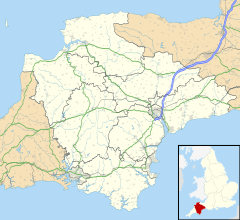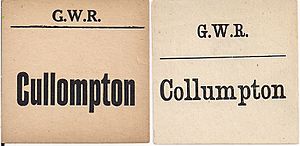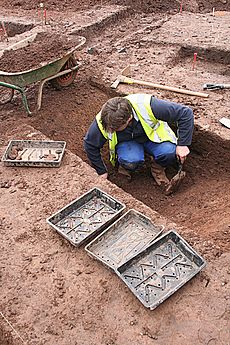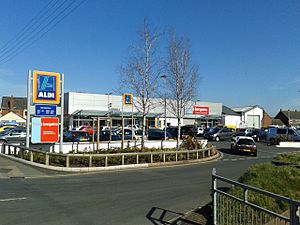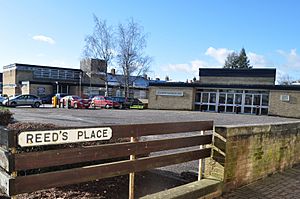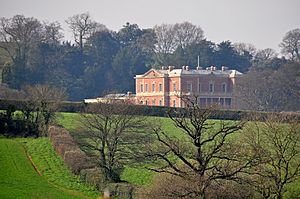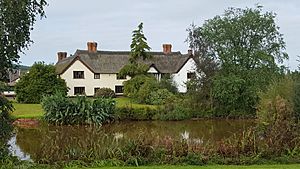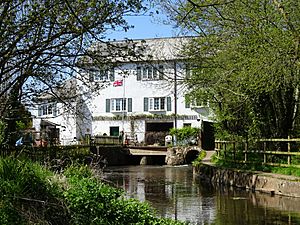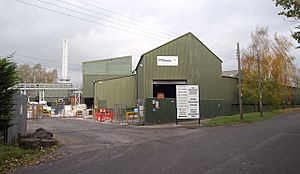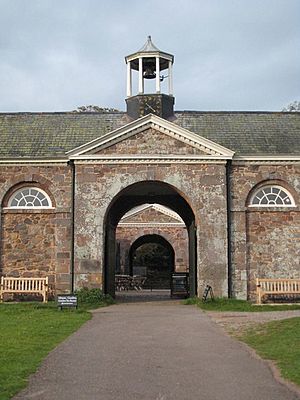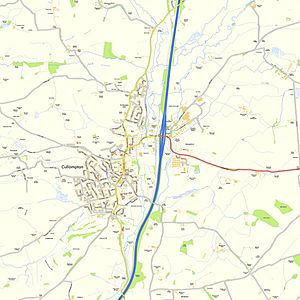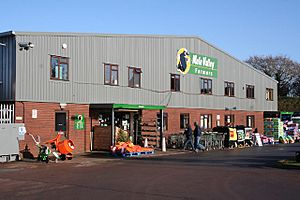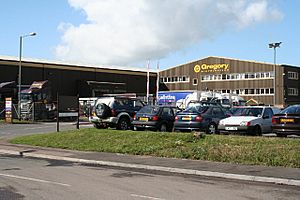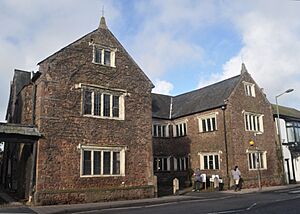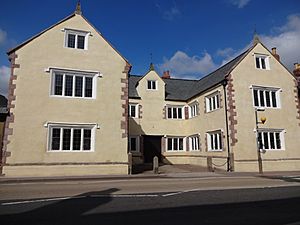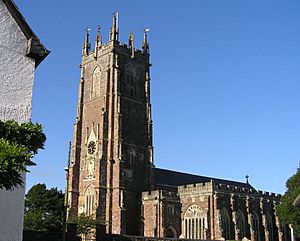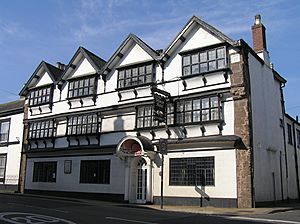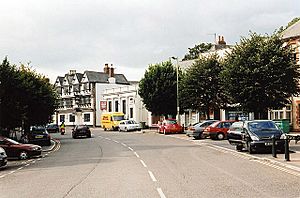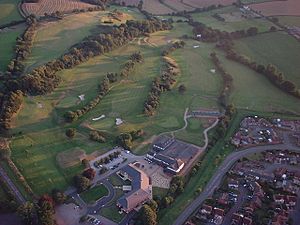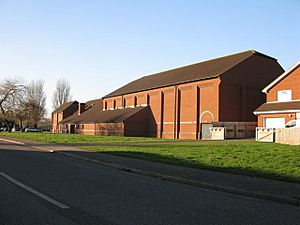Cullompton facts for kids
Quick facts for kids Cullompton |
|
|---|---|
 Cullompton: the town from the south west |
|
| Population | 10,071 (2021 census – parish) |
| OS grid reference | ST020071 |
| District | |
| Shire county | |
| Region | |
| Country | England |
| Sovereign state | United Kingdom |
| Post town | CULLOMPTON |
| Postcode district | EX15 |
| Dialling code | 01884 |
| Police | Devon and Cornwall |
| Fire | Devon and Somerset |
| Ambulance | South Western |
| EU Parliament | South West England |
| UK Parliament |
|
Cullompton (pronounced "kuh-LUMP-tun") is a town and civil parish in Devon, England. It's about 13 miles (21 km) north-east of Exeter and sits by the River Culm. In 2021, the parish had a population of 10,071 people.
People have lived here since Roman times. A Roman fort was found on a hill above the town. Cullompton was even mentioned in the will of Alfred the Great, a famous English king.
Long ago, Cullompton was known for making wool and cloth. Later, it became important for leather and paper. Today, many people who live here travel to work in other towns. But Cullompton still has some local businesses, like flour and paper mills.
The town hosts a monthly farmers' market, which is the oldest of its kind in the South West of England. Cullompton also has two very old and important buildings: St Andrew's parish church, built in the 1400s, and The Walronds, a house from the 1600s. The town centre is a special "conservation area" to protect its history.
Contents
- History of Cullompton
- Governance
- Geography
- Population and People
- Economy
- Culture and Community
- Media
- Landmarks
- Transport
- Education
- Religious Sites
- Sports and Leisure
- Notable people
- See also
History of Cullompton
What does Cullompton mean?
The name Cullompton might mean "Farmstead on the River Culm". The word "Culm" probably refers to the river's twists and turns. Another idea is that it's named after Saint Columba, who preached to people in the area around 549 AD.
In the past, Cullompton was spelled in many different ways. Even in the mid-1800s, people used three different spellings! The railway station sign used to say "Collumpton" until 1874. Today, many people lovingly call the town "Cully".
Cullompton in Roman Times
In 1984, two Roman forts were found on St Andrew's Hill, near Cullompton. These were discovered using aerial photography, which shows old structures from above. The first fort was smaller, and later a bigger one was built. The banks of the second fort can still be seen today as field boundaries.
Archaeologists have found pottery from around 50–70 AD at the site. In 2009, they also excavated a Roman settlement near Shortlands Lane. They found lots of Roman pottery, burial remains, and pieces of hypocaust tile (from Roman underfloor heating systems).
Saxon Period and Middle Ages
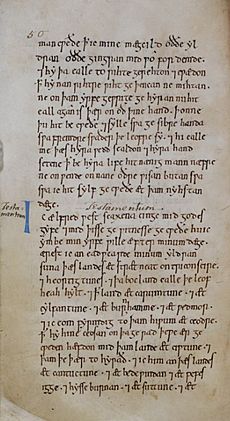
Saxon settlers arrived in the Culm Valley in the 600s. Cullompton became the site of a minster, which was an important church. In 872, Alfred the Great gave "Columtune" and its lands to his son, Æthelweard.
After the Norman Conquest in 1066, Cullompton was owned by Lady Gytha Thorkelsdóttir, King Harold II's mother. Later, William the Conqueror gave the land to his nephew. Over time, it was owned by different powerful families and religious groups, like the Abbot and Convent of Buckland Monachorum.
In 1278, Cullompton was allowed to hold its first market every Thursday. The town also got its first water supply in 1356. Water flowed from a stream into channels that went all over the town. People called "water bailiffs" made sure the water was used fairly.
From Civil War to the 1700s
During the English Civil War (1642-1651), soldiers often passed through Cullompton. Both Royalist and Parliamentarian troops marched through the town.
In the 1600s and 1700s, Cullompton saw the rise of different Christian groups, known as Dissenters. The first Nonconformist church started in 1662. By the 1700s, there were many Presbyterians, Anabaptists, and Quakers in the town. John Wesley, a famous preacher, visited Cullompton many times between 1748 and 1789.
Cullompton from the 1800s to Today
In 1839, a big fire destroyed many houses in Cullompton. About two-thirds of the town burned down, with 145 buildings lost. People donated money to help rebuild.
Cullompton has had a police station since 1857. A new one was built in 1974 and updated in 2011 to become a main police hub for the area. The town got its first steam-powered fire engine in 1914.
In 1918, the first cinema opened in the Victoria Hall. In 1977, Cullompton became "twinned" with Ploudalmézeau in Brittany, France. This means the towns have a special friendship.
A major fire in 1958 destroyed Selwood's tannery. This site later became home to supermarkets. The town grew a lot in the 1970s after the M5 motorway was built nearby, making it a popular place for people who travel to work.
In 2011, a new, much larger library opened in Cullompton. Soon after, in December 2011, the Cullompton Community Centre also opened. These new facilities provide great spaces for learning and community events.
Historic Estates and Houses
Cullompton parish is home to several historic estates. These include:
- Cullompton Manor: Mentioned in the Domesday Book, this land was given to Buckland Abbey in 1291.
- Hillersdon: An old estate, later held by the Honour of Torrington.
- Langford: Another historic estate, later connected to the Courtenay family.
- Moor Hayes: This was the home of the Moor family for many centuries. They built the Moor Hayes Chapel in Cullompton Church.
How Cullompton Made Money (Past Industries)
Cullompton has a long history of making things, from wool and cloth to leather and paper.
Cloth Trade
In the 1400s, people started weaving fine cloths like "kersies" and "serges" in the area. This was often a cottage industry, meaning people worked from their homes. John Lane, a famous local cloth merchant, even had a special part of St Andrew's church named after him.
Later, companies like Fox Brothers made high-quality woollen cloth in Cullompton until 1977. During World War I, their factory made only khaki cloth for soldiers.
Mills and Water Power
A special water channel, called a leat, runs through the town. It powered three main mills: Higher Mill, Lower Mill, and Middle Mill. Higher Mill was always a corn mill, grinding grain until 1974. Lower Mill stopped working in 1968. These buildings have now been turned into homes, but you can still see parts of the old water systems.
Leather Tanning
Tanning, which is the process of making leather, has been important in Cullompton since at least the 1500s. In the 1800s, there were three tanneries. The Crow Green tannery was owned by the Selwood family for many years. It employed many people, but it was damaged by fires several times. The demand for leather changed, and the tannery closed in 1967. Today, an Aldi supermarket stands on part of the old tannery site.
Paper Making
Cullompton's first paper mill opened in 1729. These early mills were small and used water power to make paper by hand. In 1883, Albert Reed bought the mill. His company, Reed & Smith, became one of the biggest papermakers in the UK. Today, the mill, now owned by Asia File Corporation, makes recycled coloured papers and boards.
Bell Making and Clocks
In 1746, the Bilbie family started a famous bell foundry in Cullompton. They made many bells for churches, mostly in Devon. Over the years, they cast hundreds of bells. The family also made clocks, including one for Cullompton Church in 1811. The bell foundry moved to Exeter in 1850.
Governance
Cullompton has a civil parish council with three areas: North, South, and Outer. The town council first met in 1894. Since 1995, the town has had a mayor, chosen by the councillors.
Cullompton is part of the Mid Devon District Council and Devon County Council. It is also part of the Honiton and Sidmouth area for the UK Parliament.
Geography
 |
Tiverton | Willand | Uffculme |  |
| Bickleigh | Kentisbeare, Blackdown Hills | |||
| Exeter | Clyst Hydon | Honiton |
Cullompton is about 4 miles (6.4 km) south-east of Tiverton and 13 miles (21 km) north-east of Exeter. It sits about 70 meters (230 feet) above sea level. The parish covers almost 8,000 acres (32 km²) and stretches for 7 miles (11 km) along the Culm valley.
Population and People
In 2011, the parish of Cullompton had 8,499 people. The town's population grew a lot in the late 1900s and early 2000s. This growth is expected to continue, with plans for more new homes each year.
Most people in Cullompton are of White English/Welsh/Scottish/Northern Irish/British background (94.2% in 2011). About 61.8% of the parish's population identified as Christian, and 28.7% said they had no religion.
Economy
In 2001, about 43% of people in Cullompton also worked there. Many others (19%) traveled to Exeter for work.
Shops and Markets
Cullompton has two main supermarkets, Tesco (opened 2008) and Aldi (opened 2014). Mole Valley Farmers also has a large store selling farm, garden, and hardware supplies.
The town's street market ended in the 1950s but was brought back for a trial period in 2008. Cullompton also has an indoor market in the Cullompton Town Hall every Wednesday.
The farmers' market in Cullompton is very special because it's the oldest in the South West. It started on June 13, 1998, and is held on the second Saturday of every month.
Kingsmill Industrial Estate
The Kingsmill industrial estate is home to various businesses. For example, Gregory Distribution has a large storage facility there for chilled and frozen goods. There's also a flour mill, a milk depot, and other companies.
Culture and Community
Cullompton has an annual Christmas parade to celebrate the turning on of the town's Christmas lights. In the summer, there's a festival week that includes the annual town fayre.
In 2011, the town got two new community facilities. "The Hayridge" opened in September, offering a public library, a cafe with free Wi-Fi, computer rooms, and meeting spaces. It also hosts adult learning courses. In December 2011, the Cullompton Community Centre opened, providing a large meeting area and other rooms for community use.
The Cullompton Community Association owns 32 acres (13 ha) of fields in the town centre. These fields are used for many events, like a circus, whippet racing, and firework displays.
The Culm Valley Integrated Centre for Health opened in 2008. It includes a large doctor's practice, complementary therapies, a health food cafe, and a pharmacy.
Cullompton United Charities helps local residents. They provide almshouses (special homes) for elderly residents and can offer financial help to young people leaving school for tools or further education.
Media
Local TV news for Cullompton comes from BBC South West and ITV West Country.
For radio, you can listen to BBC Radio Devon, Heart West, Greatest Hits Radio South West, Radio Exe, East Devon Radio, and TCR Radio, which is a community station from Tiverton.
The local newspaper that serves the town is the Culm Valley Gazette.
Landmarks
The way Cullompton's streets are laid out still shows its medieval plan. Most shops are along Fore Street, with small paths leading to courts behind them. This long high street shows how important the town was for the cloth trade between the 1500s and 1700s.
There are two very important buildings in Cullompton that are "Grade I listed" (meaning they are of exceptional interest): the 1400s parish church (St Andrew's) and The Walronds at 6 Fore Street. Many other buildings are also listed, showing their historical value. The town centre is a special conservation area to protect its unique character. Hillersdon House, a Victorian manor house, is also nearby.
The Walronds
The Walronds house was likely built in 1605. It has a traditional layout with a hall and two wings. The house was carefully restored, with work starting in 2011. The Heritage Lottery Fund provided a large grant to help with the restoration.
The house reopened to the public in 2014. Parts of the house are now used for holiday rentals, while other rooms are kept for public use, like meetings. The garden behind the house is planned to become a park for the town.
St Andrew's Church
St Andrew's church dates back to the 1400s. Its tall tower, about 100 feet (30 m) high, is a famous landmark. The tower was built later, between 1545 and 1549. It's made of local red sandstone with carvings.
Inside, the church has a beautiful wooden roof painted in blue, crimson, and gold. There's also an old wooden gallery from 1637 with 16 carved figures, including the twelve apostles and the Four Evangelists.
On the south side of the church is "Lane's Aisle," built between 1526 and 1529 by a local cloth merchant named John Lane. It has amazing fan-shaped stone carvings.
Cullompton Manor House
Cullompton Manor House is another important historic building. Parts of it were built in 1603 and 1718. It was originally a private home but is now part of the Manor House Hotel. It has a distinctive front with four gables and carved brackets. The house was updated in 1603 and again in 1718. During World War II, the army used it to house officers.
Cullompton Leat
A leat (a man-made water channel) runs next to the main high street, with a public footpath alongside it. The leat takes water from the Spratford Stream and flows past three former watermills before emptying into the River Culm. It's not clear exactly when the leat was first built, but it's shown on maps from the early 1600s. Today, a special board works to restore and maintain the leat.
Transport
Roads
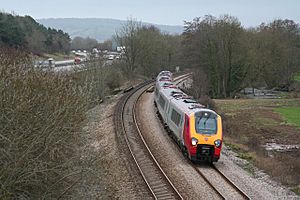
Junction 28 of the M5 is very close to Cullompton town centre. Other main roads include the A373 to Honiton and the old A38 (now the B3181) which goes through the town. In 2001, most people (61.6%) in Cullompton traveled to work by car or van.
A bypass was built in 1969, but it was later upgraded to become part of the M5. This means that traffic coming from the south to the M5 junction still has to go through the town centre, which can cause air quality problems. Improvements have been made to the M5 junction to help traffic flow better.
Railways
Cullompton railway station opened in 1844 but closed to passengers in 1964. The site is now part of the M5 motorway services. The closest train station today is Tiverton Parkway, about 5 miles (8 km) north along the M5.
There are plans to reopen Cullompton railway station. Local councils and the Department of Transport are looking into this idea.
Buses
Stagecoach South West runs regular bus services (routes 1 and 373) connecting Cullompton to Tiverton and Exeter. There's also a local town bus run by Dartline. An express bus service, the SW Falcon, stops in Cullompton on its way from Plymouth to Bristol.
Education
Cullompton has two primary schools: St Andrews Primary School and Willowbank Primary School.
The secondary school is Cullompton Community College. It opened in 1964 and became a full comprehensive school in 1979. It's for students aged 11 to 16, with about 650 students. In 2003, it became a Business and Enterprise college. In 2017, inspectors said it was one of the top 10% of schools in the country.
Religious Sites
Besides the main Parish church, St Andrew's, Cullompton has other places of worship:
- The Roman Catholic church of Saint Boniface was built in 1929.
- The Methodist church in New Cut is the third chapel on its site, with the current building dating from 1872 after a fire.
- The Unitarian chapel on Pound Square was built in 1913 and is the oldest nonconformist church in Cullompton.
- Hebron Evangelical Church was built in 1962.
- The Baptist Church is on the site of a meeting house built in 1743.
Sports and Leisure
Local Teams and Clubs
Cullompton Rugby Club started in 1892. In 2009, their senior team won a major league and then the EDF Energy Senior Vase at Twickenham. Famous rugby players like Ben Moon and Izzy Noel Smith used to play for Cullompton. Abbie Brown, who captained England in Rugby Sevens, also played here.
The local football team is Cullompton Rangers, formed in 1945. They play at Speeds Meadow.
Cullompton cricket club was set up in 1892. There are also clubs for bowls, badminton, running, squash, and Taekwondo.
Sports and Leisure Facilities
The town has the Culm Valley Sports Centre, which opened in 1985. It has a fitness studio, an all-weather pitch, a sports hall, and squash courts.
Cullompton is also home to Padbrook Park, a golf course and sports centre that opened in 1992. It includes a golf course, a hotel, a health and fitness centre, indoor bowls, and restaurants.
Notable people
- Painter and architect John Shute (died 1563) was born in Cullompton.
- Architect Charles Fowler (1792–1867) was born here.
- Richard Crosse (1742–1810), a painter, was born in Knowle, a nearby hamlet.
- The engineer William Froude (1810–1879) lived in Cullompton.
- The historian WG Hoskins (1908–1992) died in the town.
- The singer Joss Stone (born 1987) lives near Cullompton.
- John Lane (died 1528), a cloth merchant, built the Lane Chapel in St Andrew's Church.
See also
 In Spanish: Cullompton para niños
In Spanish: Cullompton para niños


